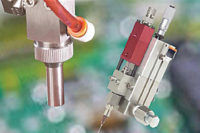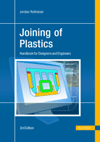
Example of clinch joint that could employ an adhesive to create a hybrid joint (image: BTM Corp.).
Aerospace and automotive manufacturers have been incorporating hybrid joining into their production for years now. This joining method, however, has been largely ignored by appliance manufacturers. A novel approach to assembly construction, the method is surely applicable within the appliance industry - and stands to benefit both appliance manufacturers and end users.
Hybrid joining refers to the use of an adhesive in combination with a mechanical method of joining. There are three main varieties of hybrid joining: riv-bonding, weld-bonding, and clinch-bonding.
Riv-bonding involves using structural adhesive, such as epoxy, methyl methacrylate (MMA), or elastomeric, along with rivets, including blind, solid, or self-piercing. Weld-bonding involves the use of adhesive with some form of spot welding, such as resistance, laser, or ultrasonic. Clinch-bonding involves the use of adhesive with the joining of two surfaces via plastic deformation of one surface onto/into another, creating an interlocked joint.
Adhesives vs. fasteners
Adhesives have high sheer and tension strengths and are usually applied across the entire bondline, making them effective at managing a large amount of load spread over a large area. Conversely, mechanical fasteners can only transfer loads to one another; this point-contact load bearing provides less sheer and tension strength.However, while adhesives have better sheer and tension strengths than mechanical fasteners, the peel strength of the latter is superior to that of the former. Peeling forces can become an issue in assemblies that are not perfectly rigid, as would be the case in thin sheet metal assemblies.
Hybrid joining, then, hinges on the synergy created by combining the sheer and tension strengths of adhesives with the peel strength of mechanical fasteners - creating new possibilities in joining assemblies.

Example of self-piercing fastener that could employ an adhesive to create a hybrid joint (image: AKH FAS-NER).
Hybrid advantages
The use of hybrid joining can produce assemblies that are lighter, more aesthetically pleasing, exhibit considerably higher strengths, and reduce complexity and production costs.For example, George Ritter, technology leader for adhesives at Edison Welding Institute, Columbus, Ohio, says that hybrid joining can be used to create assemblies made from thinner substrates using less mechanical fasteners. This is by virtue of the method’s synergistic load-bearing quality. With mechanical fastening alone a substrate of a given thickness is needed, but when adhesives enter the equation the fastener’s peel strength is coupled with the adhesive’s wide load-bearing area, this allows substrates to be thinner and reduces the number of mechanical fasteners. The load per unit length becomes distributed more evenly.
Hybrid joining also can produce assemblies that are watertight and corrosion-resistant, owing to the adhesive’s coating and sealing the substrate. Assemblies wrought by hybrid joining also exhibit high fatigue resistance, which has made the method a favorite among the aerospace and automotive industries.
Hybrid joining also can simplify the assembly process because part of the assembly itself - the mechanical fastener - doubles as a fixture. Because adhesives need time to cure, they have a very slow strength-build time compared to mechanical fasteners, which have effective strength instantaneously. In riv-bonding, for example, the rivets fixture the assembly while the adhesive cures; the same could be said for the other techniques. Hybrid joining, says Ritter, eliminates adhesive cure time as a process variable.
Also, the fixturing aspect of a hybrid joint ensures a thin adhesive bondline, says Dave Archer, president of Archtype Joint LLC, Orion, Mich. Archer says that in most cases adhesives are stronger when the bondline is thin, and hybrid joining draws materials together, ensuring a thin bondline. While riv-bonded and clinch-bonded assemblies would not require external fixturing prior to joining, some weld-bonded assemblies may require it because of a need to maintain intimate substrate contact. However, after welding, no external fixture would be needed.
Automated or not, a production line using hybrid joining may experience lower cycle time and overall cost savings. For example, in the case of riv-bonding, the number of rivets needed to produce an assembly can be reduced by up to 90 percent in some cases, say Brian Noonan and Mark Ziehm, market development managers for Henkel Corp., Rocky Hill, Conn. Cycle time reduction can occur from this need to add fewer mechanical fasteners as well as the ability of the fasteners to serve as fixtures while the adhesive cures. Furthermore, this also may translate to lower labor costs, as fewer personnel may be needed for assembly and fixturing operations. Noonan and Ziehm also say that labor savings will typically far exceed the cost of adhesives.

Example of self-piercing rivet joint that could employ an adhesive to create a hybrid joint (image: Henrob Corp.).
The assembly
Assemblies made from thin sheets of metal, such as steel, stainless steel or aluminum, are good candidates for hybrid joining.In some cases, the method can be used to join dissimilar materials. Ritter explains that when aluminum is joined to steel with ultrasonic weld-bonding, fewer welds are needed because of the adhesive; this means fewer points of metal-to-metal contact and, therefore, a reduced chance for corrosion. Furthermore, the welds would be sealed with adhesive to minimized corrosion risk. Ritter notes, however, that typically the joining of dissimilar metals is best accomplished through adhesive bonding alone, which insulates one metal from another, preventing the potential for galvanic corrosion.
Another application in which hybrid joining could be used with dissimilar materials would be the joining of composites and metal; these materials cannot be welded, but using adhesives and rivets together, for example, would create a strong joint. Joining to plastics also can be achieved with hybrid joining, say Noonan and Ziehm. This would be an option when cost or weight concerns are at issue; however, adhesive selection may be limited by such a decision.
Another aspect to consider when joining materials is substrate preparation. While adhesives generally bond parts of the same material better than parts of dissimilar materials, a lack of correct substrate preparation will greatly diminish an adhesive’s performance even when used with parts of the same material, says Archer. This means that a manufacturer would be well advised to take measures to ensure that dirty, rusty, or oily steel is not used in hybrid joining applications.
There are, however, adhesives designed for use with less than spotless substrates, having the ability to cut through contaminants on the metal’s surface. Ritter says that acrylics have this property, although the bonding strength would still be less than optimum. He goes on to add that one must keep in mind that there is still the strength of the mechanical fastener working alongside the adhesive in such a scenario.
Assemblies will have different levels of robustness depending on whether the substrate was painted before or after hybrid joining. Ritter says this is because the strength of the joint is usually limited by the bond between the paint and the metal, not the adhesive and the paint. This means that the limiting strength is reached at the paint-to-metal interface, which is weaker than that of the adhesive to paint. Ritter says that a painted, hybrid joined assembly will typically reach its limiting strength between 1,200 to 1,500 psi. To put this into perspective, he adds that a unpainted titanium-to-titanium hybrid joint withstands more than 6,000 psi.
For clean, unpainted stainless steel and sheet steel, Ritter says that a hybrid bond usually has a limiting strength of 2,500 psi. For aluminum, a limiting strength of 4,000 psi is usual. Ritter stresses that high limiting strength for any substrate really comes down to adequate surface preparation - a substrate free of contaminates.
Hybrid moments
With all the advantages inherent to hybrid joining, why has the method not been adopted by the appliance industry? Ritter says this has to do with its being a disruptive technology; if some mechanical fasteners are taken from an assembly, something else has to be added: adhesive. This means that an investment must be made in equipment and education, that company culture must be modified. So while the ultimate benefits may trump the cost - in terms of both money and effort - many manufacturers still choose to shy away.Archer brings up a very good point as to why hybrid joining should be considered. He sees the technique as an interim joining solution, saying that hybrid joining will eventually become obsolete as adhesives improve. While this does not pertain to every joining application, the types of assemblies that today employ pre-painted hybrid joining could one day be joined solely with adhesives - resulting in a more efficient assembly process for the manufacturer and a more robust, aesthetically pleasing product for the consumer.
For more information, visit:
Archetype Joint:www.archetypejoint.com
Edison Welding Institute:www.ewi.org
Henkel Corp.:www.henkel.com



